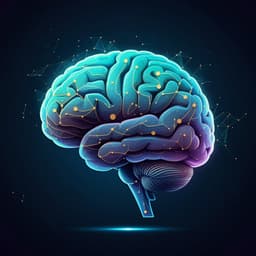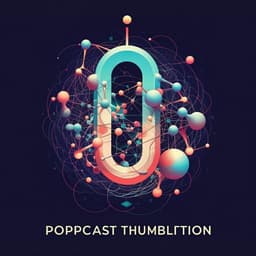
Engineering and Technology
Quantum and non-local effects offer over 40 dB noise resilience advantage towards quantum lidar
P. S. Blakey, H. Liu, et al.
This groundbreaking research by Phillip S. Blakey, Han Liu, Georgios Papangelakis, Yutian Zhang, Zacharie M. Léger, Meng Lon Lu, and Amr S. Helmy reveals a pioneering quantum-enhanced LiDAR system that outperforms classical systems with a staggering 43dB higher signal-to-noise ratio, making it a game-changer for 3D imaging in challenging, noisy environments.
~3 min • Beginner • English
Introduction
The study addresses how to achieve robust, practical quantum-enhanced LiDAR under strong environmental noise without relying on phase-sensitive detection. Prior approaches such as quantum illumination (QI) and optimal classical coherent detection require stable phase locking between interacting waves, which is difficult to maintain in practical LiDAR, making intensity-based, phase-insensitive schemes more relevant benchmarks. Phase-insensitive quantum target detection leveraging intensity and temporal correlations has shown improved noise resilience over classical counterparts, but advantages have typically been limited to a narrow noise range due to detector saturation at high noise levels. Additionally, relatively large detector timing uncertainty (jitter) erases short temporal correlations, limiting the benefits of temporal-correlation-based methods; commercial SNSPDs have ~50 ps jitter, and even sub-3 ps state-of-the-art devices trade off efficiency. The authors propose leveraging non-local dispersion cancellation to measure in a rotated time-frequency basis (Fractional Fourier domain), effectively magnifying the probe–reference temporal uncertainty while preserving their correlations. By applying opposite dispersions to probe/noise and reference paths, true probe–reference coincidences re-focus while uncorrelated noise is temporally broadened beyond detector uncertainty. Appropriately chosen coincidence windows then reject much of the broadened noise without sacrificing true coincidences. This enables substantial SNR enhancement (up to 43.1 dB over a classical phase-insensitive counterpart at the same probe flux) and tolerance to higher noise before detector saturation. The method is integrated with custom scanning/collection optics to demonstrate 3D imaging of non-reflecting targets in noisy environments.
Literature Review
The paper contrasts phase-sensitive protocols like quantum illumination (QI) with phase-insensitive schemes. While QI can offer strong theoretical advantages, it requires phase stability that is hard to maintain in practical LiDAR. Phase-insensitive quantum-enhanced target detection using correlations in intensity and time (e.g., refs. 10–14) simplifies implementation and is robust to phase noise but historically shows limited advantage at high noise due to detector saturation. Detector timing uncertainty limits exploitation of strong temporal correlations; commercial SNSPDs exhibit ~50 ps jitter, whereas sub-3 ps devices exist with reduced efficiency. Prior non-local dispersion cancellation with entangled photons has been theoretically and experimentally explored (Franson 1992; Baek et al. 2009). The present work builds on these by employing dispersion cancellation to separate true coincidences from noise in a LiDAR context, addressing detector jitter constraints and saturation in high-noise regimes.
Methodology
System and protocol: Photon pairs entangled in time-frequency are generated via femtosecond-pumped SPDC in a 10 mm Type-0 PPLN ridge waveguide pumped by a Ti:Sapphire laser at 779 nm (pump pulse ~121 ps by autocorrelation). The pump is filtered with <1.2 dB insertion loss at 785 nm and >80 dB isolation. Probe and reference photons are separated using two CWDMs: WDM1 passes the probe to the scene; the rejected band goes to WDM2 to pass the reference. Passbands were characterized by sweeping a tunable laser (Santec TSL-550) at 1 mW.
Dispersed non-classical target detection (DNCTD): The probe photon traverses the scene, accumulating loss and mixing with environmental noise assumed to be temporally and spectrally identical to the probe (worst-case after optimal classical filtering). Anomalous dispersion is applied to the probe/noise path; equal-magnitude normal dispersion is applied to the reference. Due to non-local dispersion cancellation, true probe–reference coincidences remain narrowly peaked, while noise–reference coincidences broaden substantially. A coincidence window filters out much of the dispersed noise while retaining true coincidences. Measurement is performed in a rotated time-frequency basis (Fractional Fourier domain).
Dispersion implementation: Normal dispersion uses 5 km SMF-28 (≈18 ps/(nm·km) near 1550 nm). Anomalous dispersion uses OFS LLWBDK C-168 with −172.9 ps/(nm·km); length cut to 497.5 m to balance. After dispersion, photons are detected by two SNSPDs (Quantum Opus), fiber-coupled. Detector dead time is ~25 ns.
Scanning LiDAR optics: Probe photons are collimated onto galvanometer mirrors that scan across a target within a purpose-built telescope’s field of view. A negative meniscus lens at the telescope aperture reduces angle offset to improve coupling into a single-mode fiber for SNSPDs. Time-of-flight differences between probe and reference enable ranging for 3D imaging.
Comparison protocols and SNR definitions: Three schemes are compared: classical target detection (CTD, probe singles), non-classical target detection (NCTD, probe–reference coincidences without dispersion), and DNCTD (with dispersion cancellation). For rate v (pair generation), transmissions τp and τr, and noise singles rate N, the phase-insensitive baselines are SNR_CTD = v τp / N and SNR_NCTD = sqrt(v τp τr) / N. DNCTD theory (Supplementary Note 13) predicts additional gains by dispersing noise beyond the coincidence window. To compare across conditions, noise power and probe power are normalized to √N and √τp, respectively.
Experiments and parameters: Four experiments were conducted: (1) varying noise power at fixed pair rate, transmissions, and window; (2) varying probe power (via probe path attenuation) at fixed other parameters; (3) varying coincidence window width (10–200 ps) at high noise and sufficient pair rate for stable statistics; (4) varying pump power (pair generation rate v) at maximal noise to maximize CTD–DNCTD contrast, using a 10 ps window; additional 200 ps window measurements were used to infer pair rates. Each experiment included procedures to separately measure probe-only, noise-only, and total singles/coincidences with and without 60 dB noise attenuation to extract true and noise contributions, using the provided equations. Typical integration times: 10 s per point (varying noise/probe), 100 s per window width, and up to 500 s for low-pair-rate measurements. Representative measured parameters: probe transmission ≈1.0–3.3%, reference transmission ≈7.2–7.6%; in some runs, noise singles ≈0.019–0.0404 counts/pulse. DNCTD and CTD imaging were also demonstrated with and without added noise (0 dB and 25 dB relative noise).
Key Findings
- DNCTD achieves up to 43.1 dB higher SNR than CTD at the same probe flux (maximum measured improvement at low pair rate and high noise).
- Varying noise power: DNCTD SNR is ≈14.1 dB higher than NCTD; NCTD is ≈24.5 dB higher than CTD, with approximately linear SNR dependence on normalized noise and excellent agreement with theory.
- Varying probe power: Improvement CTD→NCTD ≈26.0 dB; NCTD→DNCTD ≈12.7 dB; total ≈38.7 dB. SNR scales nearly linearly with normalized probe power and the improvements remain roughly constant across probe levels.
- Varying coincidence window: For DNCTD, reducing window from 200 ps to 10 ps yields an additional ≈3.78 dB SNR improvement over NCTD; experimental data agree with theoretical integration of coincidence distributions.
- Varying pair rate: DNCTD SNR is essentially independent of pair rate, measured at 21.45 ± 1.25 dB across rates; since CTD SNR scales with pair rate, the CTD→DNCTD advantage is maximized at low v. CTD SNR at very low v was inferred by linear fit due to singles falling below dark counts.
- 3D imaging: With 25 dB relative noise, CTD images of non-reflecting letter targets (U, O, T) are not discernible, whereas DNCTD images remain clear. Without added noise (0 dB), both methods resolve targets. Achieved ranging resolution ±0.09 cm, resolving depth differences across tilted letters.
- Noise tolerance: System tolerates up to ~3.2 × 10^6 counts/s (3.2 MHz) noise before detector saturation, exceeding prior temporal-correlation LiDAR demonstrations and far above reported 6.9 kHz and 0.4 kHz noise rates in related works.
Discussion
The findings demonstrate that non-local dispersion cancellation enables practical exploitation of time-frequency entanglement for LiDAR under strong noise, overcoming detector timing jitter and saturation limitations that constrained prior phase-insensitive schemes. By rotating the measurement basis and applying matched, opposite dispersions to probe/noise and reference paths, true probe–reference coincidences remain temporally sharp while noise coincidences are broadened, allowing narrow coincidence windows to reject uncorrelated noise efficiently. The resulting SNR gains are large, persist across a wide range of noise and probe powers, and are largely independent of pair generation rate for DNCTD. Integrating the protocol with scanning fiber-coupled collection optics yields clear 3D images even when classical CTD fails under high noise, validating applicability beyond laboratory conditions. These results advance quantum-enhanced sensing towards practical LiDAR, providing a substantial noise-resilience advantage without the complexity of phase-sensitive detection. Remaining constraints include detector saturation at very high noise and assumptions about noise indistinguishability with the probe spectrum/temporal profile, but the demonstrated margins already exceed many prior art scenarios.
Conclusion
The work proposes and experimentally demonstrates a dispersed non-classical target detection (DNCTD) protocol that harnesses non-local dispersion cancellation of time-frequency entangled photon pairs. The approach delivers up to 43.1 dB SNR improvement over a classical phase-insensitive LiDAR at the same probe flux, maintains performance across noise and probe power variations, and enables 3D imaging of non-reflecting targets under 25 dB relative noise with centimeter-scale depth precision. A purpose-built scanning telescope with efficient single-mode fiber coupling supports practical imaging. The method tolerates noise fluxes up to ~3.2 MHz before detector saturation, surpassing previous temporal-correlation LiDAR noise records. Future directions include deploying continuous-wave noise sources and modulation protocols (initial results indicate maintained advantage and ranging without a priori target position), exploring other non-local effects to further increase noise resilience, and developing optimal classical filtering compatible with broadband SPDC sources.
Limitations
- Detector saturation limits maximum tolerable noise flux to ~3.2 × 10^6 counts/s (3.2 MHz); improvements beyond this require detectors with shorter dead time or parallelization.
- Assumes environmental noise is temporally and spectrally indistinguishable from the probe after optimal classical filtering; deviations could alter performance and may necessitate additional filtering.
- Detector timing uncertainty (jitter) necessitates the dispersion-cancellation strategy; very small coincidence windows reduce true coincidences, requiring longer integration for low pair rates.
- Precise dispersion matching and stable fiber lengths are required to realize non-local cancellation; mismatch degrades SNR gains.
- In very low pair-rate regimes, CTD SNR had to be inferred by linear fits due to singles falling below dark counts, introducing estimation uncertainty.
- Some comparative measurements bypassed the scanning optics; performance with full imaging hardware under all conditions may vary and requires further characterization.
Related Publications
Explore these studies to deepen your understanding of the subject.







